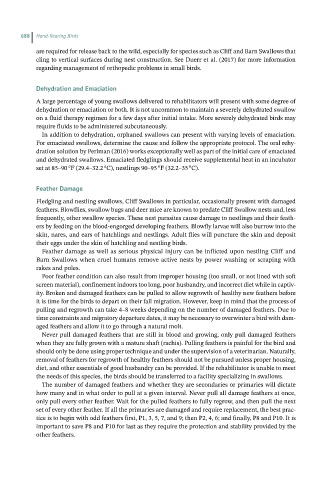Page 687 - Hand rearing birds second
P. 687
688 Hand-Rearing Birds
are required for release back to the wild, especially for species such as Cliff and Barn Swallows that
cling to vertical surfaces during nest construction. See Duerr et al. (2017) for more information
regarding management of orthopedic problems in small birds.
Dehydrationand Emaciation
A large percentage of young swallows delivered to rehabilitators will present with some degree of
dehydration or emaciation or both. It is not uncommon to maintain a severely dehydrated swallow
on a fluid therapy regimen for a few days after initial intake. More severely dehydrated birds may
require fluids to be administered subcutaneously.
In addition to dehydration, orphaned swallows can present with varying levels of emaciation.
For emaciated swallows, determine the cause and follow the appropriate protocol. The oral rehy-
dration solution by Perlman (2016) works exceptionally well as part of the initial care of emaciated
and dehydrated swallows. Emaciated fledglings should receive supplemental heat in an incubator
set at 85–90 °F (29.4–32.2 °C), nestlings 90–95 °F (32.2–35 °C).
FeatherDamage
Fledgling and nestling swallows, Cliff Swallows in particular, occasionally present with damaged
feathers. Blowflies, swallow bugs and deer mice are known to predate Cliff Swallow nests and, less
frequently, other swallow species. These nest parasites cause damage to nestlings and their feath-
ers by feeding on the blood‐engorged developing feathers. Blowfly larvae will also burrow into the
skin, nares, and ears of hatchlings and nestlings. Adult flies will puncture the skin and deposit
their eggs under the skin of hatchling and nestling birds.
Feather damage as well as serious physical injury can be inflicted upon nestling Cliff and
Barn Swallows when cruel humans remove active nests by power washing or scraping with
rakes and poles.
Poor feather condition can also result from improper housing (too small, or not lined with soft
screen material), confinement indoors too long, poor husbandry, and incorrect diet while in captiv-
ity. Broken and damaged feathers can be pulled to allow regrowth of healthy new feathers before
it is time for the birds to depart on their fall migration. However, keep in mind that the process of
pulling and regrowth can take 4–8 weeks depending on the number of damaged feathers. Due to
time constraints and migratory departure dates, it may be necessary to overwinter a bird with dam-
aged feathers and allow it to go through a natural molt.
Never pull damaged feathers that are still in blood and growing, only pull damaged feathers
when they are fully grown with a mature shaft (rachis). Pulling feathers is painful for the bird and
should only be done using proper technique and under the supervision of a veterinarian. Naturally,
removal of feathers for regrowth of healthy feathers should not be pursued unless proper housing,
diet, and other essentials of good husbandry can be provided. If the rehabilitator is unable to meet
the needs of this species, the birds should be transferred to a facility specializing in swallows.
The number of damaged feathers and whether they are secondaries or primaries will dictate
how many and in what order to pull at a given interval. Never pull all damage feathers at once,
only pull every other feather. Wait for the pulled feathers to fully regrow, and then pull the next
set of every other feather. If all the primaries are damaged and require replacement, the best prac-
tice is to begin with odd feathers first, P1, 3, 5, 7, and 9; then P2, 4, 6; and finally, P8 and P10. It is
important to save P8 and P10 for last as they require the protection and stability provided by the
other feathers.

